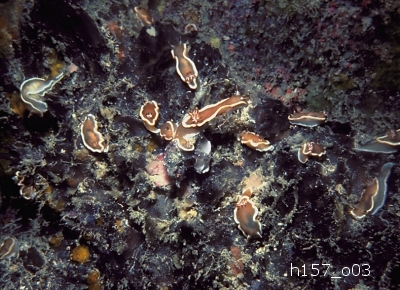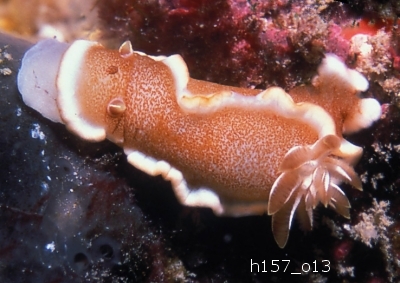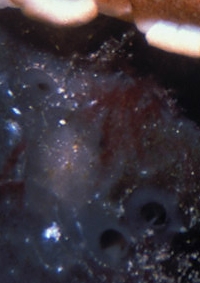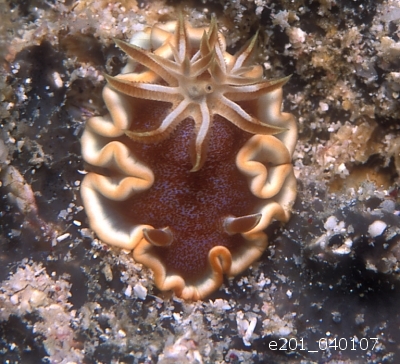Re: Glossodoris rufomarginata feeding [1]
November 17, 2008
From: Scott Johnson

Hi Bill,
After seeing Gary Cobb's recent message on Glossodoris rufomarginata and your response [#22024], I looked through the rest of the messages on that species and saw indeed that there were no photos of its food sponge. Here's one I happen to know a little bit about, since it was the most abundant species in the population study I did for my thesis in Hawaii many years ago. Of course, at the time we knew the nudibranch as Chromolaichma youngbleuthi. This species appears to exclusively eat a dark gray lumpy sponge that lives in small caves and ledges on shallow reefs (about 3-10m depth) and walls in the surge zone. In Hawaii I saw them frequently along lava coastlines where there was some vertical relief, and the gray sponge, identified at that time as a species of Dysidea but now identified as Cacospongia in Hoover, 1999 was abundant. I found the nudibranch to be strongly correlated with the presence of the sponge except in the roughest areas, where apparently the nudibranch could no longer hold on. In calmer water away from the surge zone, the sponge tapered off and disappeared, and so did the nudibranchs. Here in the Marshalls, the species lives out in the ledges of the atoll's seaward reef's groove and spur system, pounded most of the year by surf and rough conditions. It boggles my mind how it can even stay attached under the rougher conditions. The only time I can get in there to look for them is during the rare doldrums that happen to coincide with low surf, and even then the light ocean swell that is almost inevitably present makes it a bouncy dive. Actually, here at Kwajalein I see more specimens on the lagoon sides of some of these reefs, still attached to chunks of their gray sponge prey that have been torn from the rocks in the seaward reef grooves and rolled across the intertidal reef, where they end up on the lagoon slope. The nudibranchs (along with Glossodoris atromarginata, which are common in the same seaward reef grooves) eat up what remains of the sponge they rode across the reef on, then go looking for other colonies that have rolled over. It can be a tough life. Attached are three shots on the prey sponge. The two h157 numbers are from Oahu, Hawaii, and the e201 number from Kwajalein Atoll, Marshall Islands. I'll send some other information and images in separate messages [#22047, #22048 ].
Locality: h157: Oahu, Hawaii , 5 m, Pacific, Hawaii: 1979, on sponges in ledges. Length: 10-25 mm. e201: Kwajalein Atoll, 5 m, Marshall Islands, Pacific, 1 April 2007, on sponges in ledges. Length: 10-25 mm. Photographer: Scott and Jeanette Johnson.
Scott.
uwkwaj@yahoo.com



Dear Scott,
Thanks for confirming the identity of the food of G. rufomarginata. As Pat Bergquist and I discussed (Rudman & Bergquist, 2007), this sponge which has been identified as a Dysidea and also as Spongia oceania, can't be either a dysideid or a spongiid because the chemists Terem & Scheuer (1986) identified scalarane molecules from both the nudibranch and the sponge, and these metabolites are unique to thorectid sponges such as Cacospongia and Semitaspongia. Although we would need to examine the fibrous structure of the sponge to be 100% sure, Dr Bergquist, who is an expert on this group of sponges, is sure that the species misidentified as Spongia oceania is a species of Semitaspongia rather than Cacospongia. Because both the sponge and the nudibranch are in taxonomic groups which have undergone major taxonomic rearrangements in recent years it is no wonder that trying to find patterns in food specificity has been so difficult.
Your observation of animals drifting with broken-off pieces of their sponge food is very interesting as if it happens in other species, it could explain finding animals far from their food. When you describe Glossodoris atromarginata also drifting on broken-off sponge, am I right in interpreting that to mean that you have observed them eating the same sponge? Why I ask is that we have interpreted a number of earlier feeding records (Rudman & Bergquist, 2007), to refer to a species of Semitaspongia, including Keoki Stender's message [#11100] reporting it feeding on Spongia oceania in Hawaii. One feature separating sponges of the Spongiidae (such as Spongia) from those of the Thorectidae (such as Semitaspongia) is the arrangement of their fibrous skeleton, which makes spongiids tough and elastic, and thorectids brittle, with a tendency to break off parts of their colony. Your description of parts breaking off certainly suggests a thorectid sponge.
-
Cook S. de C. & Bergquist P. R. 2000. — Two new genera and five new species of the “Cacospongia ” group (Porifera, Demospongiae, Dictyoceratida). Zoosystema 22 (2) : 383-400.
-
Hoover, John P. 1999. Hawai'i's Sea Creatures, A Guide to Hawai'i's Marine Invertebrates. Mutual Publishing, Honolulu. 366pp.
-
Johnson, S. (1983) Distribution of two nudibranch species on a subtidal reef on the western shore of Oahu, Hawaii. The Veliger, 25, 356-364.
-
Rudman, W. B. & Bergquist, P. R. (2007) A Review of feeding specificity in the sponge-feeding Chromodorididae (Nudibranchia: Mollusca). Molluscan Research, 27, 60-88.
-
Terem, B. & Scheuer, P. J. (1986) Scalaradial derivatives from the nudibranch Chromodoris youngbleuthi and the sponge Spongia oceania. Tetrahedron, 42, 4409-4412.
Best wishes,
Bill Rudman
Related messages
-
Re: Glossodoris rufomarginata feeding
From: Marli Wakeing, November 18, 2008 -
Re: Glossodoris rufomarginata feeding [3]
From: Scott Johnson, November 17, 2008 -
Re: Glossodoris rufomarginata feeding [2]
From: Scott Johnson, November 17, 2008 -
Glossodoris rufomarginata from sthn Queensland
From: Gary Cobb, November 14, 2008 -
Damaged Glossodoris rufomarginata from Bunaken
From: Nigel Thomas, July 6, 2007 -
Glossodoris rufomarginata laying egss
From: Erwin Kodiat, January 14, 2006 -
Glossodoris rufomarginata from North Sulawesi
From: Erwin Kodiat, November 10, 2005 -
Unknown Glossodoris from Lembeh
From: Fred Wobus, August 22, 2005 -
Glossodoris rufomarginata on shark
From: Kristin Anderson, April 22, 2005 -
Original illustration of Doris picta Pease 1860
From: Bill Rudman, March 7, 2005 -
Glossodoris rufomarginata from Malaysia
From: Paul Tan, June 22, 2004 -
Glossodoris rufomarginata from Japan
From: Yukari Sato, December 3, 2003 -
Glossodoris rufomarginata from Korea
From: Dong Bum Koh, June 21, 2003 -
Glossodoris rufomarginata from Myanmar
From: Sarah Heaney, March 14, 2003 -
Glossodoris rufomarginata from French Polynesia
From: Danny Van Belle, December 17, 2002 -
Glossodoris rufomarginata and egg ribbon
From: Nishina Masayoshi, July 27, 2002 -
Glossodoris rufomarginata from Taiwan
From: Todd Garthwaite, June 17, 2002 -
Hong Kong Glossodoris rufomarginata
From: W. B. Rudman & B. W. Darvell, January 22, 2002 -
What is this sea slug?
From: Fumio Kihara, November 2, 2001 -
Glossodoris rufomarginata from Japan
From: Toshihiro Horiuchi, September 8, 2001 -
Glossodoris rufomarginata from the Solomons
From: Bruce Potter, February 10, 2001 -
Glossodoris rufomarginata from Philippines
From: Erwin Koehler, January 23, 1999
